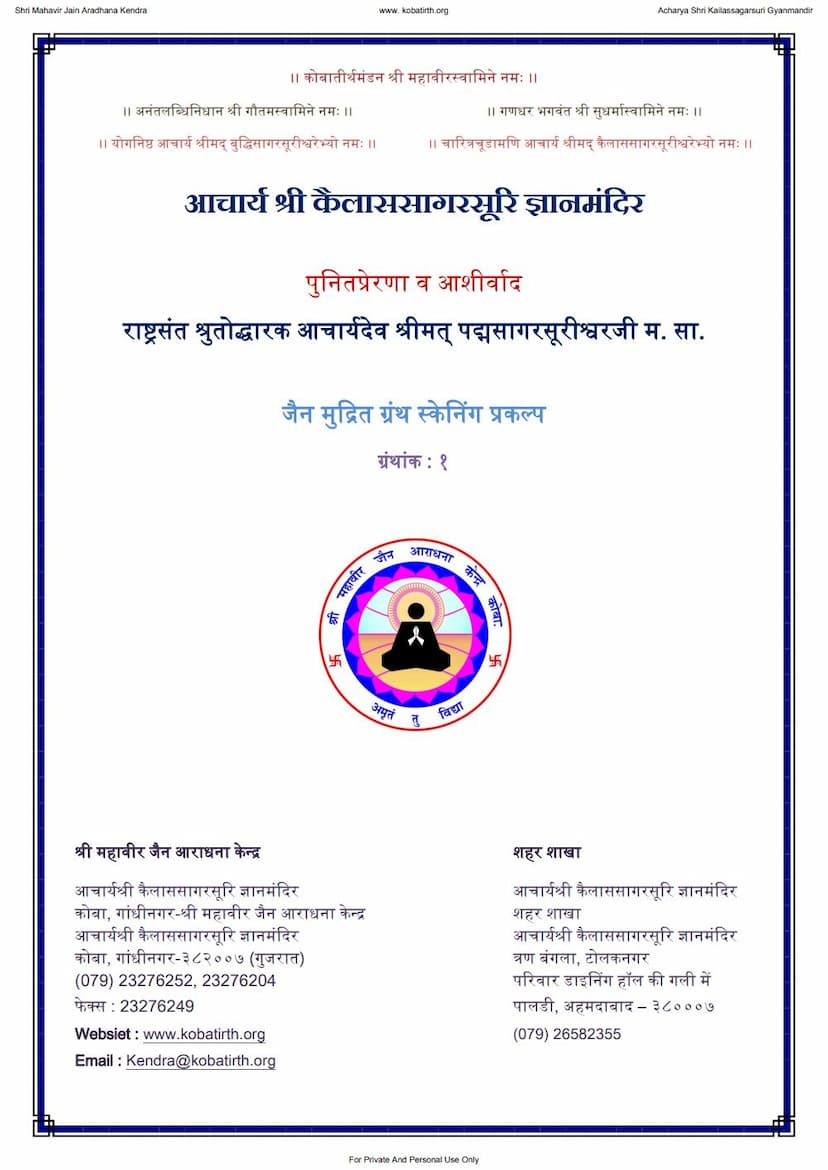Vishva Gunadarsh Champu
Added to library: September 2, 2025

Summary
This is a comprehensive summary of the provided Jain text, the "Vishva Gunadarsh Champu," based on the scanned pages:
Book Title: Vishva Gunadarsh Champu Author(s): Gangadev Bhatt, Mahadev Sharma (These appear to be the editor/researcher, as the main author of the original text is indicated as Venkatadhvarin/Maheṅkaṭādhvari). Publisher: Tukaram Jawaji Mumbai Publication Year (of this edition): 1910 AD (Shaka 1832)
Overall Nature of the Text:
The "Vishva Gunadarsh Champu" is a significant Sanskrit literary work, specifically a Champu kavya, meaning it is composed in a mixture of prose and verse. The text, as presented in these scanned pages, is an edition with a commentary called "Padarthachandrika" by Balakrishna Sharma, and it was published by Tukaram Jawaji in Mumbai in 1910.
Author and Context:
The primary author of the "Vishva Gunadarsh Champu" is Mahakavi Sri Venkatadhvari (Maheṅkaṭādhvari). The introduction (Bhumika) extensively discusses the author's life, lineage, and philosophical affiliations.
- Lineage: Venkatadhvari was the grandson of Appaya Dikshita and the son of Raghunatha Dikshita. Appaya Dikshita was a renowned scholar and author of works like "Kuvalayananda" and "Chitramimamsa."
- Philosophical Affiliation: Venkatadhvari was a follower of the Sri Ramanuja school of Vaishnavism. The introduction delves into details about Ramanujacharya, his teachings, and the various sub-sects that emerged, particularly the "Vadagale" (Northern) and "Thengale" (Southern) traditions, highlighting their historical context and doctrinal differences.
- Time Period: Based on the commentary and historical references, Venkatadhvari is estimated to have been a contemporary of Nilakantha Dikshita, placing him around the 17th century AD (circa 1637 AD).
Literary Style and Content:
- Champu Genre: As a Champu, the work blends ornate prose with verses, creating a rich and varied literary experience.
- Theme: The title "Vishva Gunadarsh" translates to "Mirror of Worldly Qualities." The text aims to describe and illustrate various aspects of the world, its phenomena, places, and the qualities and foibles of its inhabitants.
- Narrative Structure: The introduction describes the narrative device used: two Gandharvas named Krashanu (critic) and Vishvasu (appreciator) travel through the celestial and terrestrial realms, observing and commenting on different aspects. Krashanu often points out flaws or negative aspects, while Vishvasu highlights the positive or contextualizes them.
- Subject Matter: The text covers a vast range of topics, including:
- Descriptions of Nature: Sun, rivers (Ganga, Yamuna, Kaveri, Bahu Nadi), seas, forests, mountains (Venkata Giri).
- Descriptions of Places: Holy sites (Badrinath Ashram, Ayodhya, Kashi, Jagannath Kshetra, Gurjar Desha, Maharashtra, Andhra Desha, Karnataka Desha, Chola Desha, Kanchi, Kumbhakhona, Setu).
- Biographies and Teachings: Detailed accounts of religious figures and philosophical traditions, particularly concerning Vaishnavism (Ramanujacharya, the Vadagale/Thengale debate).
- Critiques of Practices: The text, especially through the dialogue between Krashanu and Vishvasu, critiques certain perceived laxities or deviations from scriptural norms in different regions and among different communities, including Brahmins and ascetics.
- Mythological Narratives: Incidents from the lives of deities like Vishnu (in his various avatars like Rama, Krishna, Narasimha, Varaha) and Shiva are narrated to illustrate specific points.
- Literary Criticism: The commentary also touches upon literary aspects like the use of figures of speech (Alankaras), rhythm (Vritta), and poetic flaws (Doshas).
Commentary (Padarthachandrika):
The commentary by Balakrishna Sharma aims to elucidate the meaning of each word and phrase in the original text. It provides grammatical explanations, clarifies obscure references, and offers interpretations of the philosophical and literary aspects. The commentator expresses a desire to improve upon existing commentaries.
Key Themes and Debates Discussed:
- The Nature of Poetry: The introduction defines poetry and its types, distinguishing between pure poetry (Kavya), Champu, drama, etc.
- The Divine: The text discusses the omnipresence and grace of the Supreme Being (Vishnu) and the devotional practices associated with Him.
- Critique of Religious Practices: A significant portion of the discussion, particularly through Krashanu's critiques, centers on perceived deviations from Vedic and scriptural norms in various religious traditions and regional practices. This includes criticism of certain Brahminical practices, ascetic behavior, and the mixing of philosophical schools.
- The Role of the Poet and Scholarship: The introduction emphasizes the importance of poetry for spiritual and intellectual development and highlights the scholarship of the author and the commentator.
- Debate and Argumentation: The dialogue between Krashanu and Vishvasu serves as a literary device to present differing perspectives, with Vishvasu often defending or contextualizing the subject matter against Krashanu's criticisms.
Significance:
The "Vishva Gunadarsh Champu" is a valuable source for understanding the cultural, religious, and literary landscape of India during the 17th century. It provides insights into the prevalent philosophical debates, regional customs, and the appreciation of Sanskrit literature during that era. The commentary by Balakrishna Sharma further enhances its accessibility and scholarly value.